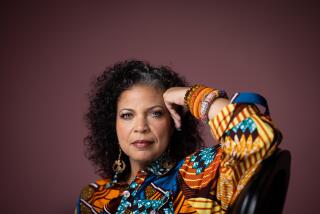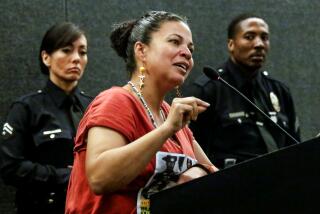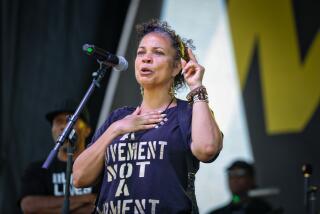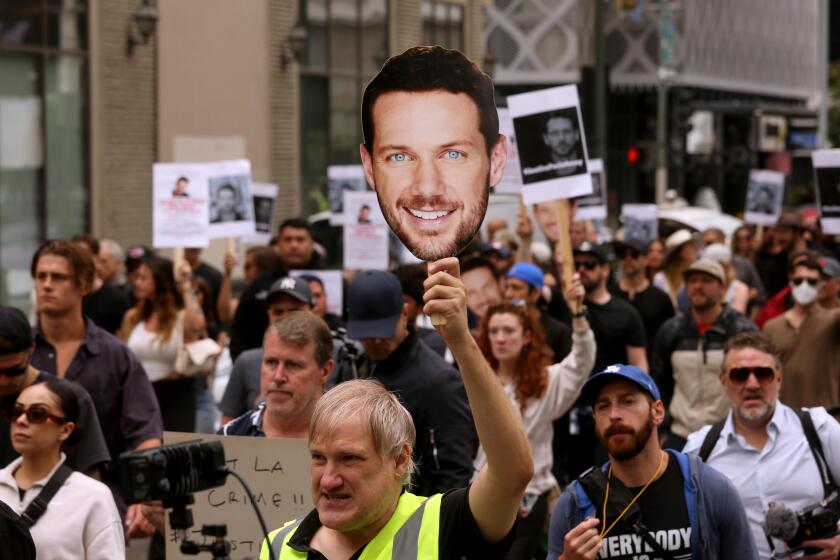How two Black women in L.A. helped build Black Lives Matter from hashtag to global movement
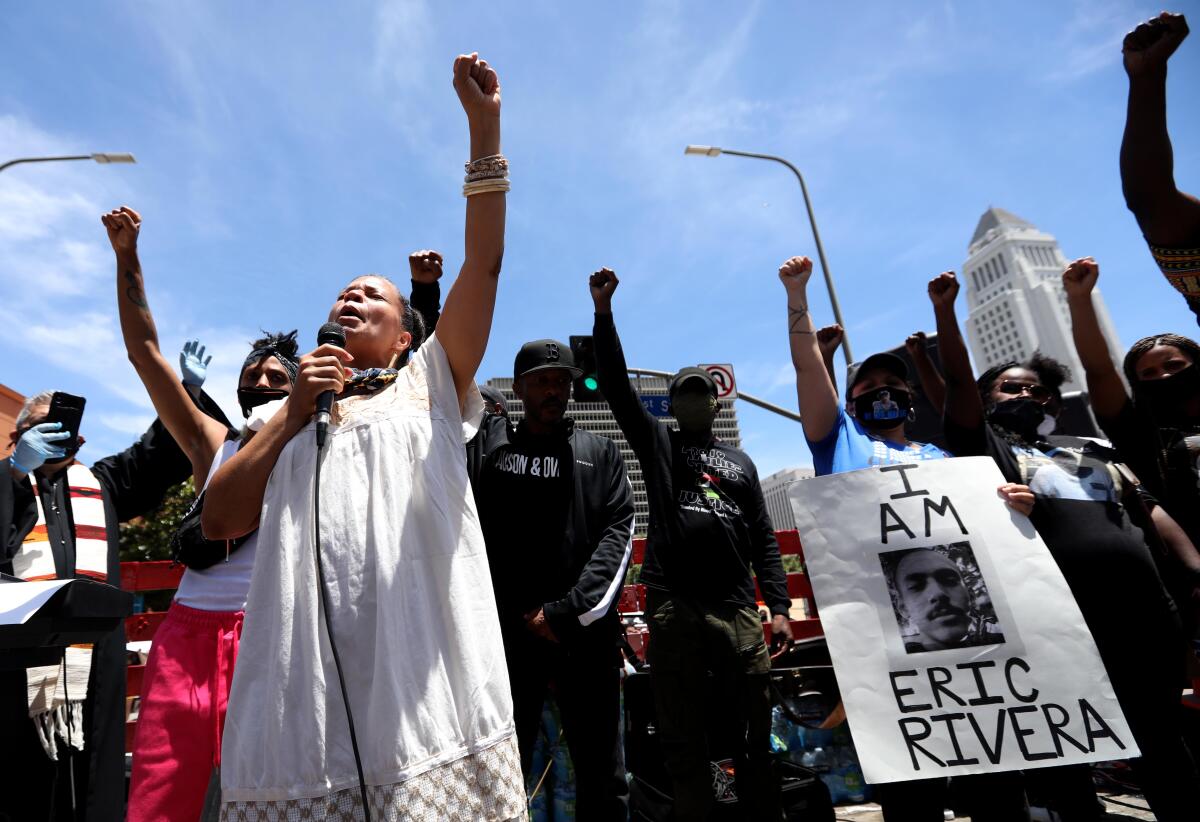
Melina Abdullah stood in the bed of a white pickup truck parked in the middle of Vine Street in Hollywood before a sea of people whose end she could not place.
Speaking into a microphone, she told the crowd on that early June day that they were going to honor the spirits of people whose lives had been stolen by police violence.
She called out George Floyd. She called out Ryan Twyman. She called out Wakiesha Wilson. She called out Kisha Michael. After each name, she poured water from a plastic bottle onto the hot pavement below, while protesters responded with “Àse” (ah-shay), a word used by the Yoruba people of Nigeria akin to ending a prayer with “Amen.”
“Our power comes not only from the people who are here but from the spirits that we cannot see,” said Abdullah, a Cal State L.A. professor, single mother of three and the leader of Black Lives Matter Los Angeles. “When we say their name, we invoke their presence.”
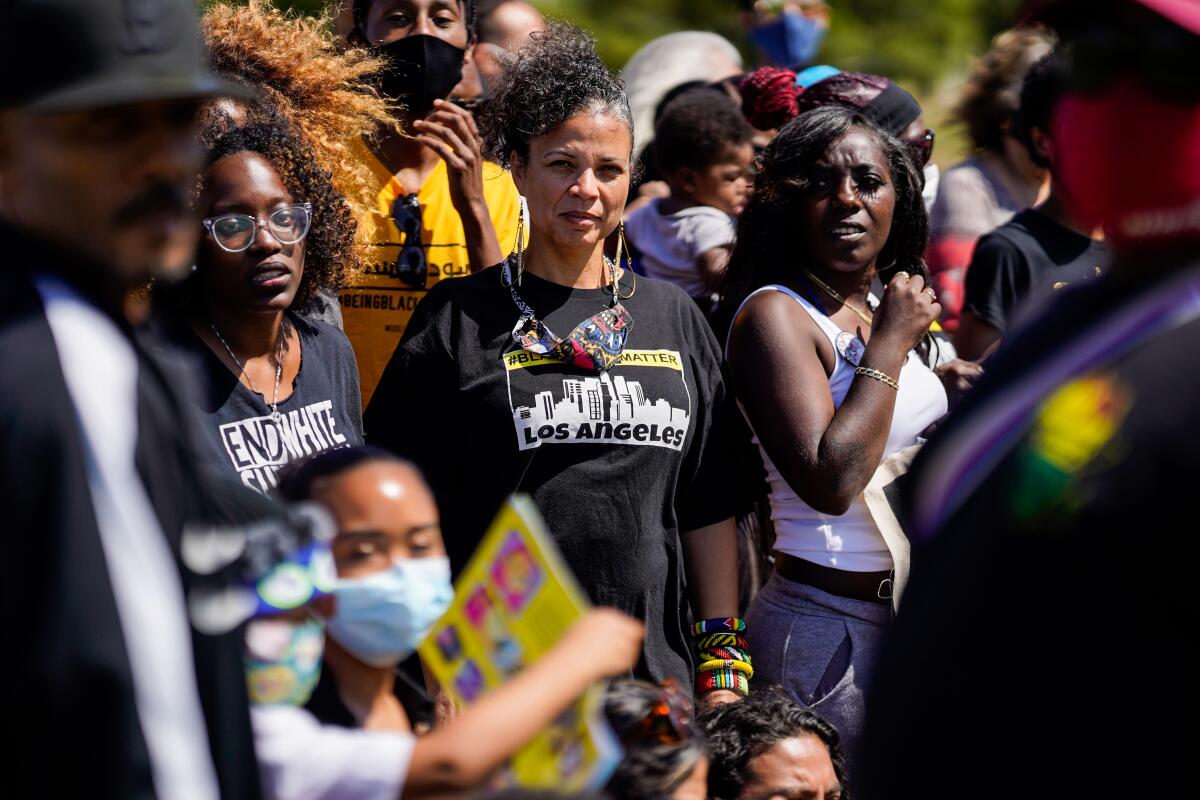
Then they marched.
The unprecedented size and scope of recent rallies speaks to how Black Lives Matter has transformed from a small but passionate movement into a cultural and political phenomenon. And in few places has that movement generated more passion than in Los Angeles, home to two of BLM’s guiding forces, Abdullah and Patrisse Cullors.
A core group of Los Angeles activists has worked relentlessly for years protesting LAPD actions, advocating criminal justice reform, speaking out at Police Commission meetings and picketing outside City Hall. Now, four weeks after Floyd was killed when a Minneapolis police officer pressed his knee into Floyd’s neck for nearly nine minutes, members are continuing to channel their outrage and grief over his killing into a sustained mass campaign for profound social change.
The group has political sway that would have seemed unimaginable just a few months ago, with defunding police now becoming a mainstream political policy question. And their protests have brought together a melting pot of people demanding change.

It’s been seven years since the group formed after George Zimmerman’s acquittal in the killing of 17-year-old Trayvon Martin. On July 13, 2013, Alicia Garza, an Oakland activist, posted what she called a love letter to Black people on Facebook, telling them, “Our lives matter.” Los Angeles activist Cullors turned it into a hashtag: #BlackLivesMatter. New York activist Opal Tometi built the digital platform.
A few days later, Cullors called her friend Abdullah and 30 others together to form the first chapter of what is now a network of 16 across North America.
The movement spread after protests erupted nationwide in 2014 when a white police officer in Ferguson, Mo., shot and killed Michael Brown, an unarmed Black 18-year-old.
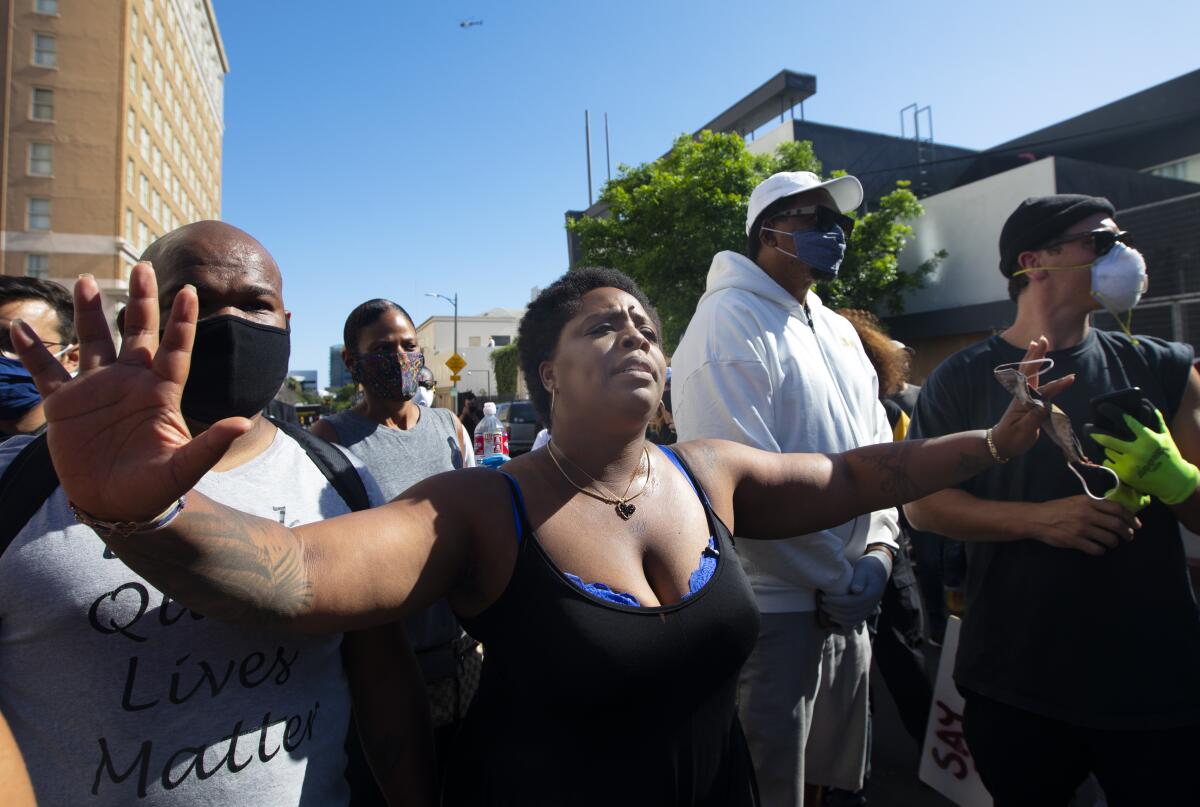
Between instances of nationwide unrest, BLM L.A. has pursued racial justice reforms and supported the families of those killed by law enforcement in the region. The organization has been viewed by some as controversial for its confrontational tactics and rejection of so-called respectability politics. But its approach has also attracted young Black people and embraced those who are LGBTQ.
Despite its growing renown among Black Americans, only recently has Black Lives Matter become a household phrase among people outside the Black community. Cullors, 37, likens the organization to an underground cult band that has now broken into the mainstream.
Leadership within the movement is decentralized. But Cullors, who serves as chair of the BLM Global Network Foundation, the group’s international arm, assists her hometown chapter when needed. She also collaborates with organizers outside BLM under the broader Movement for Black Lives, a national coalition of more than 100 organizations.
With nearly 100,000 estimated protesters, the June 7 Hollywood protest was the biggest organized gathering so far in Los Angeles since Floyd’s death.
BLM has made it easier for people to lean into social justice, Cullors said, in part through use of social media and the engagement of celebrities like the rapper YG, who promoted that protest and used footage from it in a music video for his song “FTP,” which is an abbreviation for “F— the police.”
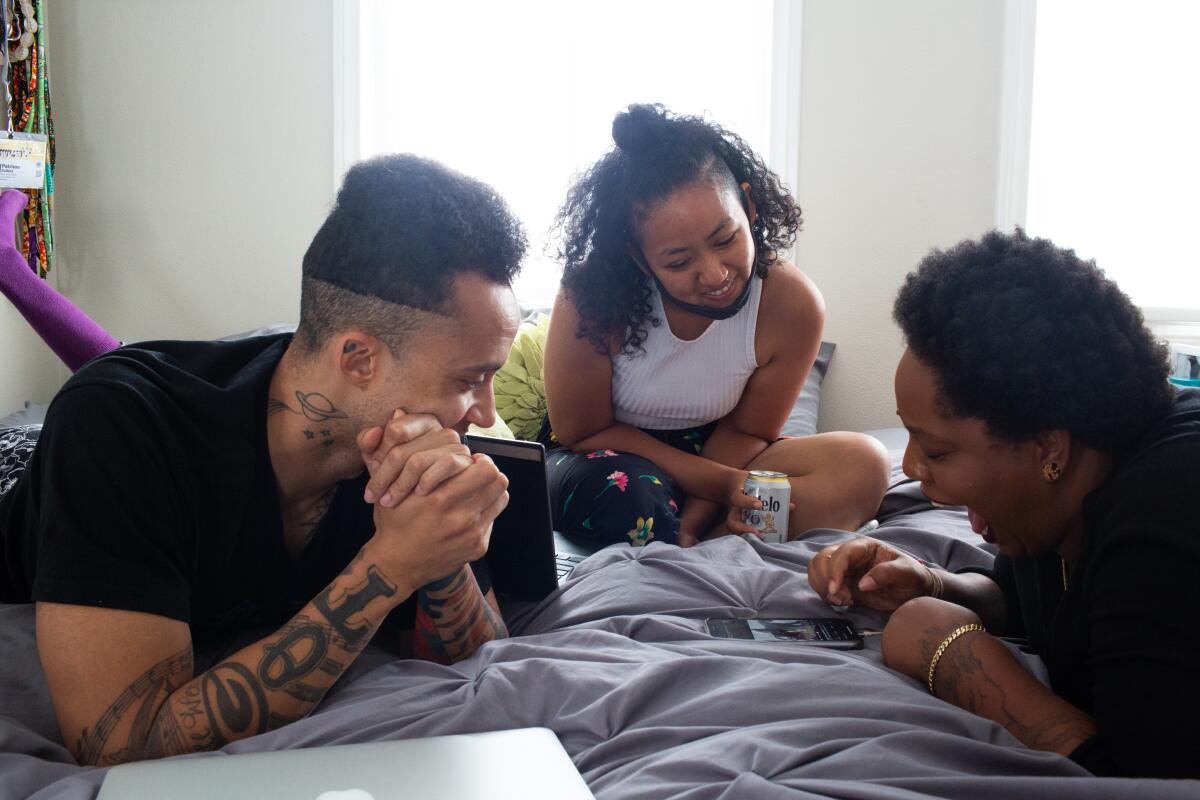
“It’s unheard of in L.A. to bring out 100,000 people to protest,” Cullors said. “That’s very New York, that’s very Chicago. L.A. is a very apathetic town.”
Before the march began, E’Layjiah Wooley approached Cullors to ask how she could join the movement. The 19-year-old with curly pink hair told Cullors that they’d met a year before at a march in Oakland and that she had just moved to Los Angeles.
“You’re in the right place,” Cullors told her.
Cullors, who grew up in Van Nuys in the 1990s, said her earliest memory of police is watching officers force their way into her home while looking for her uncle and ransacking the place without acknowledging the family. She was 7.
For Cullors, the mother of a 4-year-old boy, the current struggle is being waged for this generation — and those to come.
“This is a movement led and envisioned and directed by Black women,” she said. “Many of us are queer, we’re moms, and we really started this work because we wanted to see our children survive. We’re laying the groundwork and foundation for a new world, not just for our descendants but for right now.”
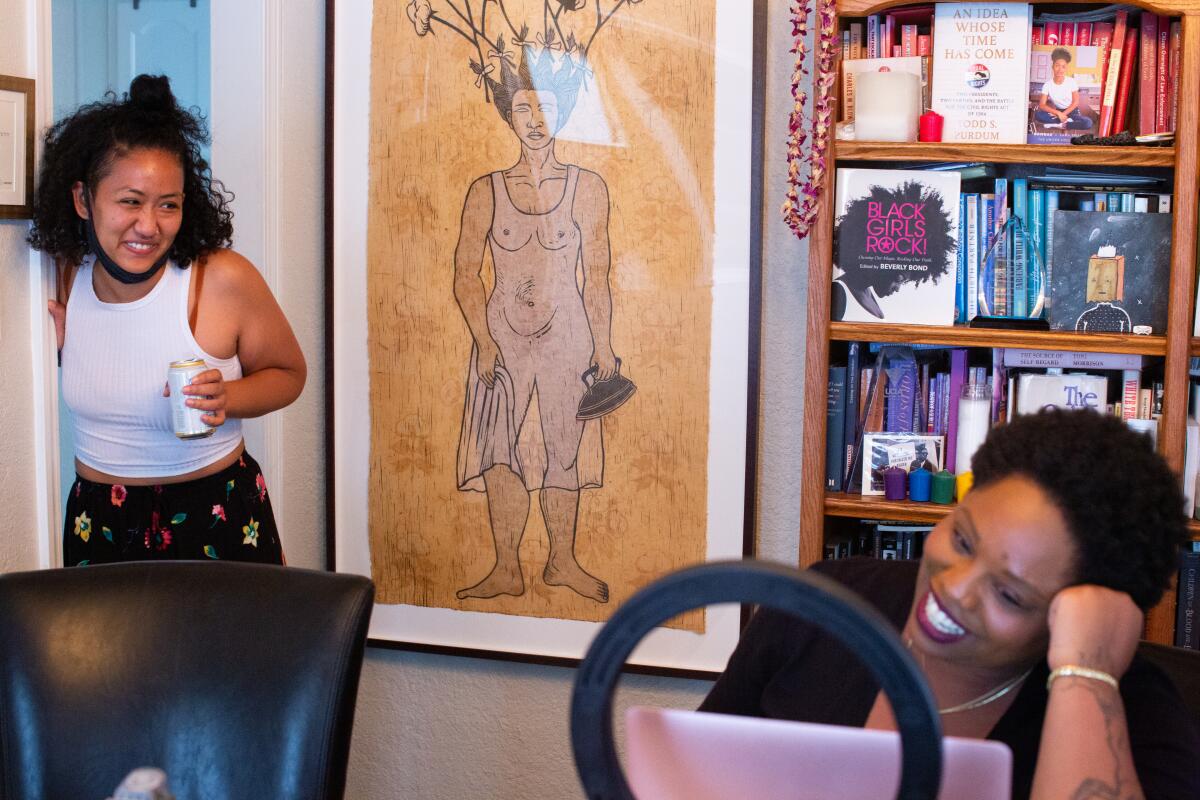
With 500 members, the L.A. chapter is one of the biggest and most influential in the BLM network.
The core leadership team consists of five people, including Abdullah, who manages messaging and strategy. She said she tries to ensure that members have a say in most decisions, though the core team takes on alone issues that could risk danger or arrest. None of the leaders are paid for their organizing work.
Scot Brown, a professor of African American studies and history at UCLA, said people like Abdullah are the “real heroes” for leading the resistance long before there was international support.
“There was a time when this movement was vilified,” he said. “Now it’s become the chant that affirms human rights.”
The current moment has brought a wave of support from other progressive organizations. But at times, good intentions have proved insufficient.
This month, the group behind the yearly LA Pride parade organized a march in solidarity with Black Lives Matter. But its leaders came under fire after they submitted a special event permit application to the Los Angeles Police Department.
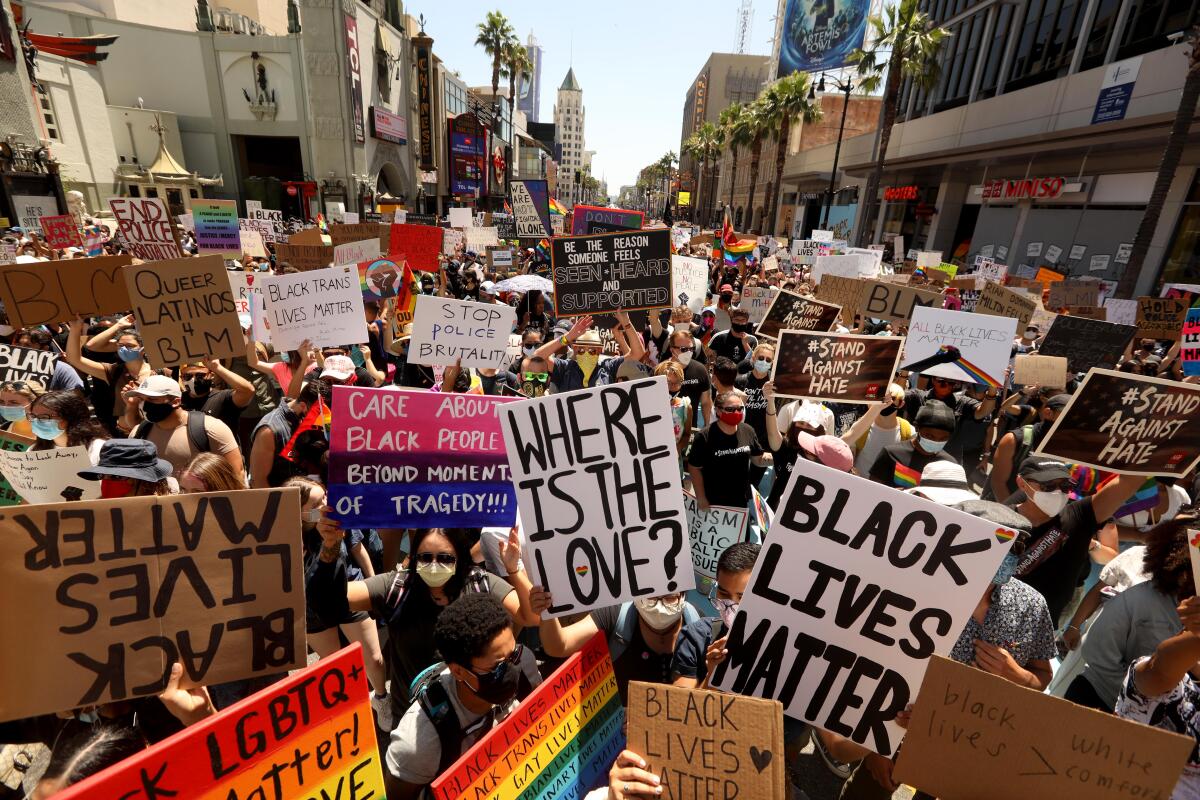
As a matter of practice, Black Lives Matter Los Angeles does not collaborate with police on any of its events. Under pressure, LA Pride apologized and said it would step back from the event. The All Black Lives Matter solidarity march did take place at the direction of a newly formed group, Black LGBTQ+ Activists for Change, whose board is composed entirely of Black LGBTQ people.
For Abdullah, the situation illustrates the deeper thinking that must occur when people consider what solidarity really means.
“It’s more than just saying ‘Black lives matter’ or painting it on the street,” she said.
Abdullah, who is in her 40s, grew up the daughter of two schoolteachers in East Oakland during the rise of the Black Panther Party. She now teaches pan-African studies at Cal State L.A. — and was supposed to spend this year writing a book. In September, she took her first sabbatical in 18 years.
While Abdullah is more the academic theorist, Cullors flourishes in the world of art. Originally trained as a dancer, her work lives at the intersection of performance and activism. For her master’s thesis last year at USC’s Roski School of Art and Design, Cullors contrasted the “history of Black bodies being harmed, tortured and brutalized” with pieces designed to showcase respite and healing. This month, she performed “A Prayer for the Runner,” which centers on a prayer she contributed to writing after the killing of Ahmaud Arbery in Georgia.
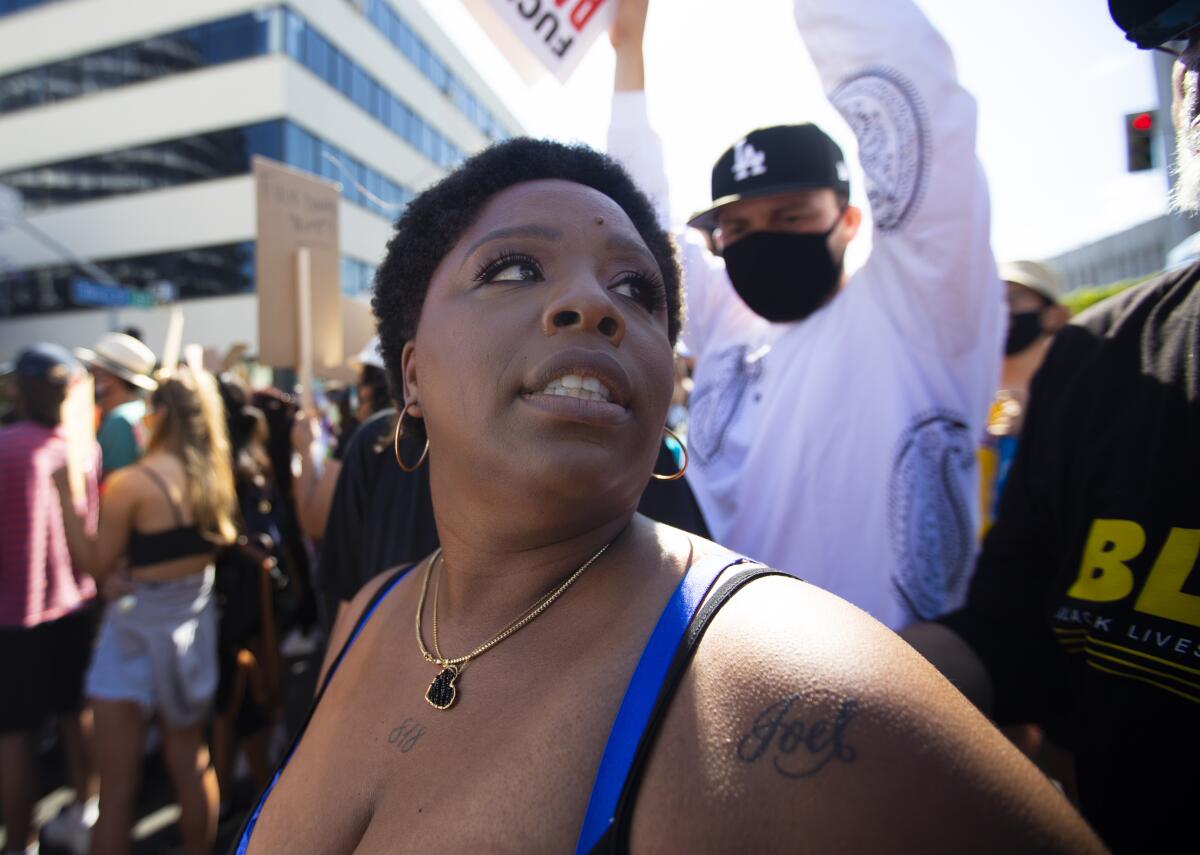
Cullors released her first book, a “poetic memoir” co-written with Asha Bandele about Black Lives Matter titled “When They Call You a Terrorist,” in 2018. Art, she believes, is essential to the movement.
“We didn’t build it as a policy think tank; we built it as a cultural movement,” she said. “That’s why everybody feels moved by it. It’s why it tugs at people’s hearts. It’s why it pisses people off. It’s why people felt like they had to pick a side.”
That’s what it did for the mother of Grechario Mack, 30, who was having a mental episode when he ran through the Baldwin Hills Crenshaw Plaza shopping mall with a knife and was shot dead by police. The Los Angeles Police Commission later ruled that the 2018 shooting violated department policy.
Catherine Walker, Mack’s mother, said the leaders of BLM L.A. have become like a second family to her during a three-year period when she lost three family members. She spoke at a protest June 3 that drew thousands.
Having that platform has made her feel validated, Walker said.
“Even though my son is gone, George Floyd opened our doors to show there is hope that justice can be gotten,” she said.
BLM L.A. helps families like Walker’s by ordering independent autopsies, which can cost upwards of $6,000. Abdullah said those autopsies can make all the difference in wrongful-death lawsuits. The organization also requests body-cam video from police departments, removes the narration by law enforcement officials and pushes the raw footage back out on social media.
“We try to strip it of their narrative, so that people can see what actually happened,” Abdullah said.
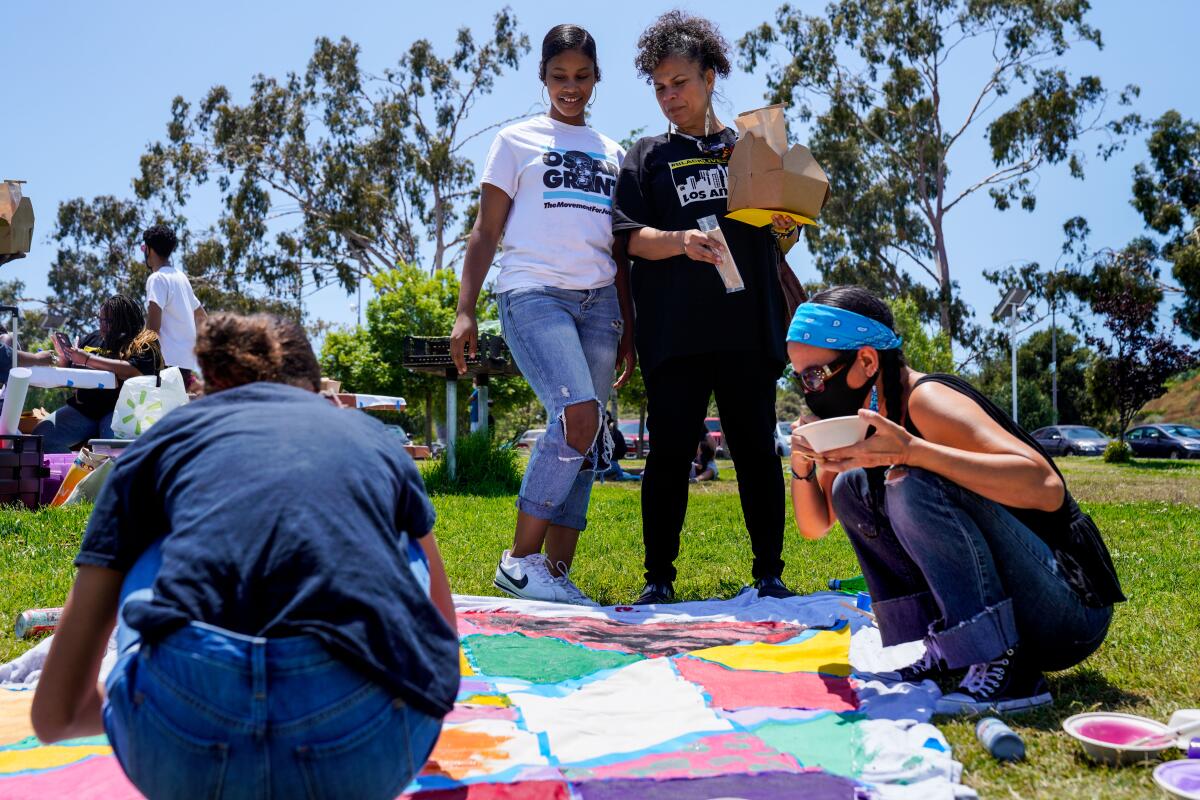
That kind of continued support is part of the core mission of BLM L.A., whose two main tenets are to prosecute police whose use of force is unjustified and to defund police departments while shifting resources toward social services including mental health, schools and housing.
BLM organizers, who take inspiration from the civil disobedience tactics of the Black Power era of the 1970s, have clashed at times with veteran activists in L.A.’s Black community, who say those actions distract from their message. Others question BLM’s follow-through after moments of confrontation.
Longtime community activist Earl Ofari Hutchinson, president of the Los Angeles Urban Policy Roundtable, said BLM’s tactics opened city leaders’ eyes to the seriousness of police violence. Without the recent protests, he said, leaders would never have agreed to reduce the LAPD budget.
“However, without sustained, focused political engagement and a structured organization to carry out a concrete program for police overhaul, the great danger is that when the moment passes they will take back every one of the gains,” Hutchinson said.
Juliet Hooker, a political science professor at Brown University who has studied the BLM movement, called it the most effective Black political mobilization since the civil rights era.
“It’s only seven years old and there are these massive protests all over the U.S., all over the globe in solidarity and raising questions about racism in their own local context,” she said. “That’s an enormous potential transformation in political consciousness.”
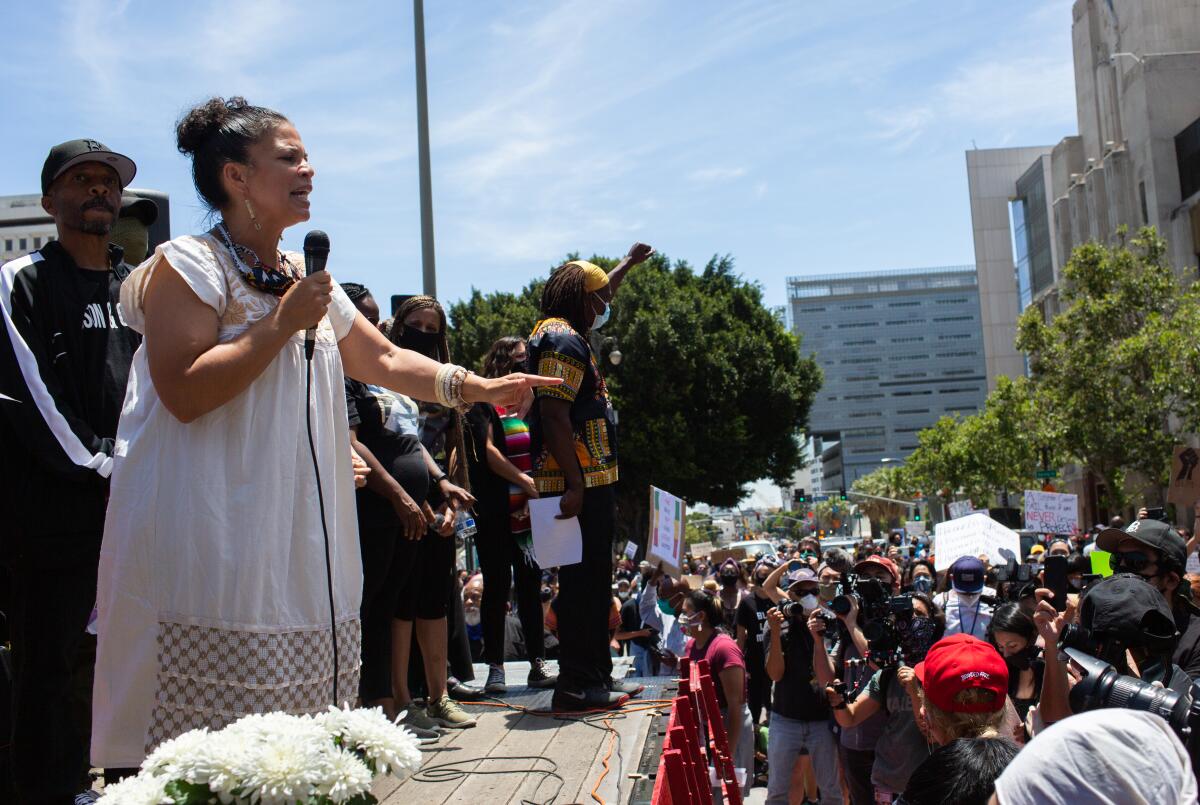
It’s too early, Hooker said, to judge BLM on legislative or policy outcomes. But she said that the groundwork for those changes is being laid now and that political candidates have no choice but to address systemic racism ahead of the November election.
Increasingly, BLM’s strategy appears to be working. At Los Angeles City Hall on Monday, Abdullah urged City Council members to stop relying on police and embrace new strategies for public safety.
“The world is speaking right now,” she said at the meeting. “They’re saying we don’t want a system of policing that puts targets on the backs of Black people.”
Abdullah’s remarks came during a special meeting devoted to the People’s Budget, an alternative spending plan for City Hall that would allocate 5.7% of the city’s general fund to the LAPD, a reduction of about 90% compared with Mayor Eric Garcetti’s spending plan for the upcoming budget year.
Garcetti said that the city needs more law enforcement reforms and that leaders are exploring how to respond to nonviolent 911 calls with medical and mental health workers. He announced a moratorium on adding people to the CalGang database and new processes for reporting police misconduct.
“But we can’t limit our law enforcement budget to a point that would deny our communities critical emergency services,” he said. “We have to continually work to improve all of our government services, including policing.”
Law enforcement officers have killed more than 880 people, including Twyman, in Los Angeles County since 2000. Almost all were men and nearly 80% were Black or Latino. In the vast majority of cases, the use of force was deemed legally justified by the L.A. County district attorney’s office.
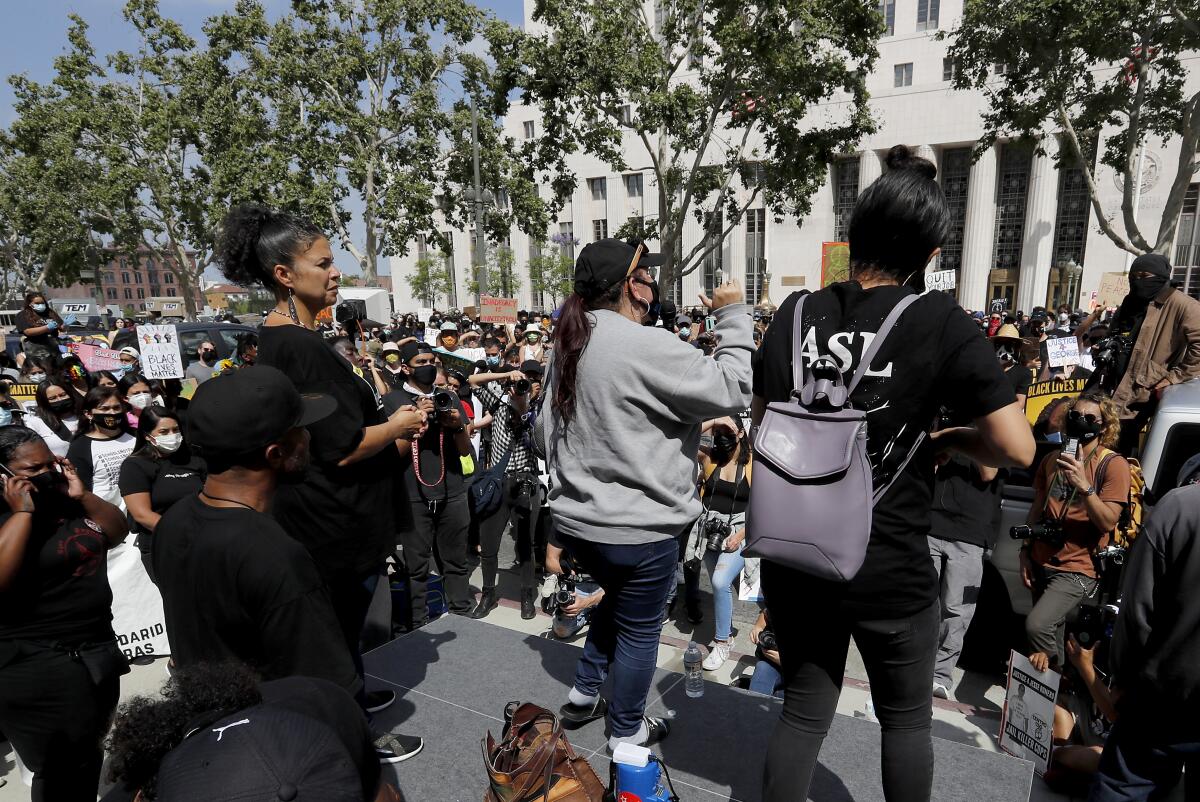
Local organizers with Black Lives Matter have built momentum through aggressive tactics — camping out at City Hall, shutting down freeways — and targeting top law enforcement officials and Garcetti. They advocated firing former Police Chief Charlie Beck and his successor, Michel Moore, as well as L.A. County Dist. Atty. Jackie Lacey, over their perceived mishandling of police shootings and misconduct.
Though the Police Commission, a civilian panel that oversees the LAPD, was praised for passing reforms including de-escalation training, use of body cameras and limiting the use of chokeholds, Abdullah has maintained that those don’t go far enough.
Among Black Lives Matter organizers’ achievements, they count the firing of the five Inglewood officers who fatally shot Kisha Michael and Marquintan Sandlin in 2016; the end of a Los Angeles Unified School District policy of randomly searching students with metal detectors; the 2019 arrest of Democratic donor Ed Buck, accused of preying on gay Black men and forcibly injecting them with fatal doses of methamphetamine; and Police Commission rulings of wrongdoing by officers in the deaths of numerous L.A. residents at the hands of police.
They also say they forced Lacey into a November runoff election against progressive challenger George Gascón.
After public pressure last year, city prosecutors dropped eight misdemeanor charges against Abdullah after she allegedly grabbed the arm of an LAPD officer during a contentious Police Commission meeting. In February, Abdullah filed a federal lawsuit alleging that the police and city attorney’s office illegally targeted her for prosecution because of her activism.
A day before the primary election in March, Lacey’s husband pointed a gun at Abdullah and other unarmed Black Lives Matter protesters during a confrontation outside the couple’s home, telling them: “I will shoot you. Get off of my porch.”

State officials are reviewing whether Lacey’s husband committed a crime and should face prosecution. After the incident, Lacey apologized on her husband’s behalf but also derided the protesters for what she called repeated harassment and threats throughout her two terms in office.
Recent BLM protests have come against the backdrop of the COVID-19 pandemic, which has disproportionately killed Black Americans. Abdullah said she’s fighting a more existential threat.
“We pray that we don’t get sick,” she said. “But if we do, it is what it is because my children are under greater threat by these officers who kill people than they are by COVID-19.”
After days of protests, which at times were marred by instances of vandalism and theft, local officials lifted curfews and pulled back the heavy police presence. Faced with growing criticism over the mass arrests of hundreds of peaceful demonstrators, top law enforcement officials said they will not pursue criminal or financial penalties against the protesters.
Garcetti committed to making a $250-million investment in communities of color. The money will be cut from city operations, including as much as $150 million from the Los Angeles Police Department, which has a budget of $1.8 billion. Abdullah called the cuts a positive step forward but said that commitment came after five years of pressure to defund police while the department’s budget increased.
On the Monday after the big Hollywood march, Abdullah’s day started with a radio interview at 4 a.m. She tuned into the city’s Budget and Finance Committee meeting and then spoke at a news conference in front of City Hall in support of defunding the Los Angeles School Police Department.
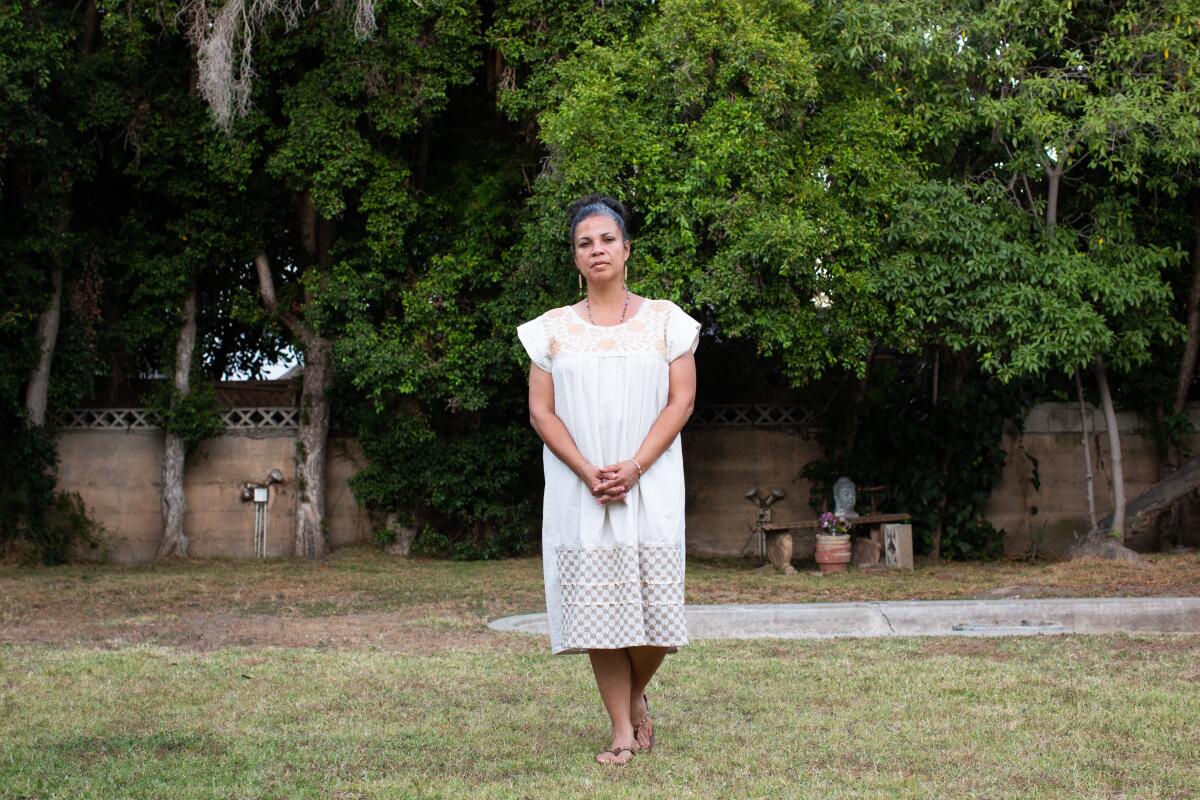
When she got home close to 7 p.m., she pulled her hair into a bun and sank into her burnt orange sectional for a conference call.
During the initial weeks of the coronavirus stay-at-home orders, Abdullah said, she slowed down for the first time since Black Lives Matter Los Angeles was established. She returned to cooking family dinners of eggplant Parmesan and fried fish and greens. The family grew closer.
Then Floyd was killed. And though Abdullah regularly brings her children to protests and other actions, she worries she isn’t giving them the same attention as mothers who aren’t leading a social movement.
For Abdullah, this historic moment means 20-hour days that end with her answering emails until her eyes get blurry and she crashes on the couch. It’s a sacrifice she’s willing to make — for her own children, for those whose parents died at the hands of police and for a vision of a better United States that for so long has been maddeningly out of reach.
“We decided as a family — we talked about it, that we got to be all in in this moment,” she said. “But it’s not going to be forever.”
More to Read
Sign up for Essential California
The most important California stories and recommendations in your inbox every morning.
You may occasionally receive promotional content from the Los Angeles Times.
